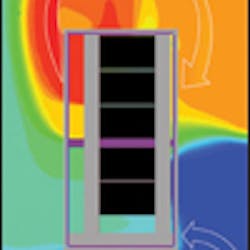Hot or Cold, Partial or Full? Airflow Containment Raises Questions. CFD Modeling Has Answers.
In order to make these determinations, Chatsworth Products (CPI) recommends leveraging the value of engineering analysis. In this case, that means a Computational Fluid Dynamics (CFD) model. By definition, CFD models use numerical analysis and data structures to analyze and solve problems that involve fluid flows. In the data center, that means describing the before and after conditions of airflow in particular, as well as the relative supply and return temperatures of that air.
These CFD models are used to demonstrate and validate the results of adding airflow containment, while also providing guidance on which containment solution—and just how much containment—will work best for your application. Simply put, when CFD is used, especially before any timely or costly construction begins, it can help justify making design changes to your planned or legacy data center.
Benefits of CPI CFD Modeling
If you have decided to implement a containment solution, consider the benefits of CPI CFD Modeling. CPI provides an expert panel of data center design consultants, field application engineers and technical support to start. They'll conduct a rigorous checklist of your installation's existing and planned airflow, equipment placement and more. Through this precise mathematical analysis, design and placement recommendations are enhanced by a variety of CPI-observed factors including:
- Shape and size of the data center
- Raised floor and ceiling heights
- Location and type of computer room air conditioner (CRAC) units
- Location and open area of perforated tiles, cut-outs and under-floor obstructions
Once these elements have been captured and recorded, CPI CFD Modeling will assist in creating an optimized installation based on better airflow, maximized network equipment performance and the elimination of wasteful power usage and cooling techniques. These insights provide clear direction for devising an intentional airflow management strategy, which ultimately helps to ensure optimal efficiency and operation before timely and costly construction begins.
Posted by Brittany Mangan, Digital Content Specialist at 3/19/2019
